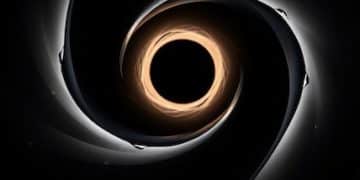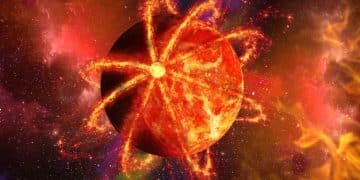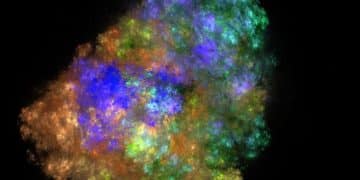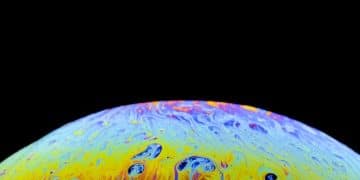Dark Matter Breakthroughs: What Webb Could Uncover in the Next 6 Months

What New Discoveries About Dark Matter Could the James Webb Telescope Reveal in the Next 6 Months? The James Webb Space Telescope (JWST) might detect subtle distortions in light from distant galaxies caused by dark matter, map dark matter’s distribution through gravitational lensing, and potentially identify new, lighter dark matter particles influencing star formation in the next six months.
The universe remains a vast enigma, and one of its most persistent mysteries is what new discoveries about dark matter could the James Webb Telescope reveal in the next 6 months?. As we peer deeper into the cosmos, the James Webb Space Telescope (JWST) offers unprecedented opportunities to unravel the secrets of this elusive substance.
Unveiling Dark Matter with the James Webb Space Telescope
The James Webb Space Telescope (JWST) is poised to revolutionize our understanding of dark matter. By observing the universe in infrared light, JWST can penetrate the dust clouds that obscure our view in visible light, potentially revealing the subtle effects of dark matter on distant galaxies.
Gravitational Lensing: A Key to Mapping Dark Matter
One of the primary ways JWST can detect dark matter is through gravitational lensing. This phenomenon occurs when the gravity of a massive object, such as a galaxy or a cluster of galaxies, bends and magnifies the light from objects behind it.
- Detecting faint, distant galaxies that are only visible due to the magnification effect of gravitational lensing.
- Creating detailed maps of dark matter distribution by analyzing the distortions in the shapes of lensed galaxies.
- Studying the internal structure of dark matter halos surrounding galaxies.
By carefully analyzing the distorted images of these background galaxies, scientists can infer the distribution of dark matter in the foreground lensing object. This is particularly effective when observing galaxy clusters, where large concentrations of dark matter create significant lensing effects.
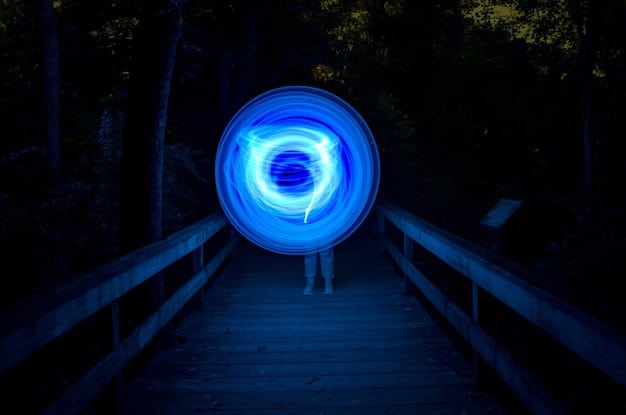
Gravitational lensing offers a unique opportunity to “see” dark matter, even though it does not interact with light directly. JWST’s high resolution and sensitivity make it an ideal instrument for this type of observation.
In conclusion, the study of gravitational lensing with JWST promises to provide unprecedented insights into the distribution and properties of dark matter, furthering our understanding of the universe’s fundamental composition.
Searching for Dark Matter’s Influence on Galaxy Formation
Beyond gravitational lensing, JWST can also shed light on dark matter by examining its influence on galaxy formation. The prevailing cosmological model suggests that dark matter halos provide the scaffolding upon which galaxies form and evolve.
JWST’s ability to observe the earliest stages of galaxy formation can help scientists understand how dark matter shapes the structure of galaxies. By studying the distribution and kinematics of stars and gas in these early galaxies, we can infer the properties of the underlying dark matter halo.
- Identifying the smallest galaxies that are still forming stars, as these are likely to be dominated by dark matter.
- Measuring the rotation curves of galaxies to determine the amount of dark matter present.
- Studying the distribution of dark matter in dwarf galaxies, which are particularly sensitive to the effects of dark matter.
Furthermore, JWST’s infrared capabilities will allow it to observe galaxies at high redshifts, corresponding to earlier epochs in the universe. These observations can provide valuable information about the evolution of dark matter halos and their role in shaping the observed distribution of galaxies today.
The link between dark matter and galaxy formation is central to our understanding of the cosmos. JWST’s observations will offer crucial data to refine and test our models.
In conclusion, by studying galaxy formation, especially in the early universe, JWST can indirectly reveal the properties and distribution of dark matter, contributing to a more complete picture of cosmic evolution.
Exploring Dark Matter Particle Candidates
While JWST cannot directly detect dark matter particles, it can indirectly probe their properties by searching for signatures of their interactions with ordinary matter. Many theoretical models predict that dark matter particles can annihilate or decay, producing observable signals such as gamma rays, X-rays, or neutrinos.
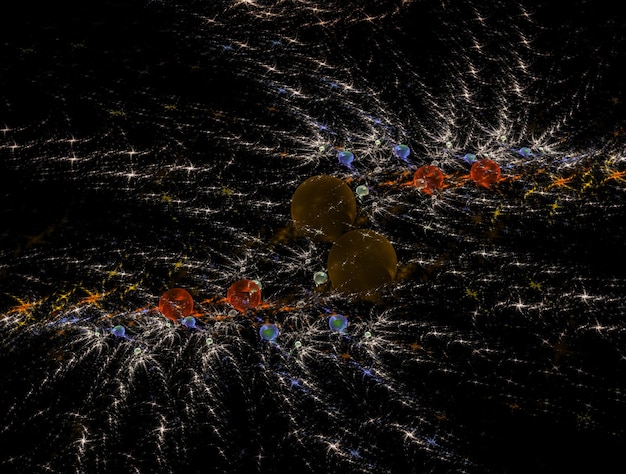
One promising avenue is to search for gamma-ray signals from dark matter annihilation in the galactic center or in dwarf galaxies. While other telescopes, such as the Fermi Gamma-ray Space Telescope, have already searched for these signals, JWST’s sensitivity to infrared light can provide complementary information about the distribution of dark matter in these regions.
Axions and Sterile Neutrinos: Potential Dark Matter Candidates
Two popular dark matter candidates are axions and sterile neutrinos. Axions are hypothetical particles that are much lighter than electrons, while sterile neutrinos are heavier particles that interact very weakly with ordinary matter.
If dark matter is composed of axions, it may be possible to detect their interactions with photons through a process called axion-photon conversion. This process can occur in the presence of strong magnetic fields, such as those found in neutron stars. JWST could potentially observe these conversions by searching for subtle changes in the polarization of light from distant quasars that pass through these magnetic fields.
- Searching for spectral lines associated with the decay of sterile neutrinos.
- Studying the effects of warm dark matter (such as sterile neutrinos) on the formation of small-scale structures in the universe.
- Looking for unusual patterns in the cosmic microwave background that could be indicative of dark matter interactions.
Exploring different dark matter candidates will help narrow down the possibilities and guide future experiments designed to directly detect dark matter particles. JWST’s capabilities will be crucial in this endeavor.
In conclusion, although JWST can’t directly catch dark matter, its observations of potential interaction signatures will provide valuable constraints on dark matter particle properties, bringing us closer to understanding this fundamental aspect of the universe.
Analyzing the Bullet Cluster and Other Colliding Galaxy Clusters
The Bullet Cluster is a famous example of two galaxy clusters that have collided. Observations of the Bullet Cluster provide strong evidence for the existence of dark matter, as the dark matter component of the clusters has passed through the collision relatively undisturbed, while the hot gas component has been slowed down.
JWST can contribute to our understanding of the Bullet Cluster by providing more detailed observations of the distribution of stars and galaxies in the cluster. This information can be used to refine our models of the collision and to better understand the properties of dark matter.
Studying other colliding galaxy clusters can help confirm that the behavior observed in the Bullet Cluster is not unique.
Mapping Dark Matter Distribution in Colliding Clusters
By carefully mapping the distribution of dark matter in these clusters, scientists can test whether its behavior is consistent with the predictions of the cold dark matter model. This model assumes that dark matter particles are non-relativistic, meaning that they move slowly compared to the speed of light.
If dark matter particles are too light or interact too strongly with each other, they may behave differently than predicted by the cold dark matter model. Observations of colliding galaxy clusters can help constrain the properties of dark matter particles and test the validity of the cold dark matter model.
JWST’s high-resolution images can distinguish between the different components in merging clusters, helping to validate or challenge existing dark matter theories.
In conclusion, JWST’s detailed observations of colliding galaxy clusters, like the Bullet Cluster, will allow scientists to refine dark matter models and constrain the properties of dark matter particles.
Constraints on Dark Matter Self-Interaction
One of the open questions about dark matter is whether it interacts with itself through some unknown force. If dark matter particles do self-interact, it could lead to observable effects on the distribution of dark matter in galaxies and galaxy clusters. Currently, scientists don’t know the characteristics of dark matter. Therefore, it is difficult to know how it may interact with itself. Fortunately, JWST may provide insight into this.
- Measuring the shapes of dark matter halos in galaxies and comparing them to the predictions of simulations that include self-interactions.
- Studying the distribution of dark matter in dwarf galaxies, as these are particularly sensitive to the effects of self-interactions.
- Looking for evidence of dark matter “cores” in galaxies, where the density of dark matter is lower than expected due to self-interactions.
JWST’s high-resolution observations can help constrain the strength of dark matter self-interactions. If dark matter particles interact too strongly with each other, it would lead to observable differences in the distribution of dark matter compared to the predictions of simulations that do not include self-interactions.
Constraining the strength of dark matter self-interactions is essential for understanding the fundamental nature of dark matter and its role in the universe.
In conclusion, JWST’s detailed observations can set new limits on dark matter self-interactions, providing valuable insights into the fundamental properties of this mysterious substance.
The Role of Baryonic Feedback Processes
Baryonic matter, which includes ordinary atoms and ions, can also influence the distribution of dark matter in galaxies. Supernova explosions and active galactic nuclei (AGN) can inject energy into the surrounding gas, pushing it away from the center of the galaxy. This process, known as baryonic feedback, can alter the gravitational potential of the galaxy and affect the distribution of dark matter.
JWST can help disentangle the effects of baryonic feedback from the effects of dark matter self-interactions. By observing the distribution of stars and gas in galaxies, scientists can estimate the amount of energy injected by baryonic feedback processes.
Combining JWST Data with Simulations
This information can then be used to improve simulations of galaxy formation and to better understand how baryonic feedback affects the distribution of dark matter. By carefully comparing the results of simulations with JWST observations, scientists can constrain the properties of dark matter and baryonic feedback processes.
Understanding baryonic feedback processes is essential for accurately modeling the formation and evolution of galaxies. JWST’s contribution will be very helpful.
In conclusion, JWST will play a critical role in distinguishing the effects of baryonic feedback from those of dark matter, leading to a more nuanced understanding of galaxy formation and evolution.
| Key Point | Brief Description |
|---|---|
| 🔭 Gravitational Lensing | JWST maps dark matter by analyzing light distortions. |
| 🌌 Galaxy Formation | Dark matter’s role in shaping galaxies is studied via early formations. |
| ✨ Particle Clues | JWST looks for signals from dark matter particle interactions. |
| 💥 Cluster Collisions | Colliding clusters help refine dark matter models. |
[Frequently Asked Questions]
No, JWST cannot directly observe dark matter. Instead, it detects its presence through indirect methods such as gravitational lensing and its influence on galaxy formation.
Gravitational lensing occurs when the gravity of a massive object bends and magnifies light from objects behind it. Scientists use it to map dark matter distribution by analyzing distortions in lensed galaxies.
JWST can search for signals from dark matter annihilation or decay, such as gamma rays or unusual patterns in the cosmic microwave background, providing clues about dark matter particle properties.
The Bullet Cluster is a collision of two galaxy clusters where dark matter has separated from ordinary matter. It provides evidence for dark matter’s existence and helps refine dark matter models.
Baryonic feedback processes, like supernova explosions, can affect the distribution of dark matter. JWST helps disentangle these effects by observing the distribution of stars and gas in galaxies.
Conclusion
In the coming months, the James Webb Space Telescope holds immense promise for advancing our understanding of dark matter. Through its unparalleled capabilities in infrared observation, JWST can probe gravitational lensing effects, trace dark matter’s influence on galaxy formation, and potentially unveil clues about its particle nature. These observations will significantly contribute to unraveling one of the universe’s deepest mysteries, bringing us closer to a comprehensive understanding of the cosmos.
